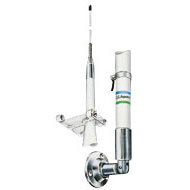

Marine Antenna Systems
An antenna is a transducer designed to transmit or receive electromagnetic waves. In other words, antennas convert electromagnetic waves into electrical currents and vice versa. Antennas are used in systems such as radio and television broadcasting, point-to-point radio communication, wireless LAN, radar, and space exploration. Antennas usually work in air or outer space, but can also be operated under water or even through soil and rock at certain frequencies for short distances.
A Brief History of Antennas
The development of antenna technology traces back to the late 19th century with pioneers like Heinrich Hertz and Guglielmo Marconi. Hertz's experiments validated electromagnetic wave theory, while Marconi's innovations enabled the first transatlantic radio signals. In maritime contexts, antennas were rapidly adopted for Morse code and early voice transmission, becoming standard safety equipment aboard vessels.
Through the 20th century, antennas evolved alongside electronics—shrinking in size while expanding in capability. Advances in materials, digital signal processing, and multi-band tuning have led to today's highly efficient, durable, and application-specific marine antennas.
Contact us today for a free consultation or quote request if you need expert advice on choosing the right antenna for your vessel.
Marine Antenna Types
PSI offers a wide selection of marine antenna systems including AM/FM, VHF, SSB, cellular, TV, combination antennas, antenna mounts, and accessories. These are available by manufacturer and application to suit every marine communication need.

Understanding Antenna Fundamentals
Antennas operate across a range of frequencies, each with unique characteristics and applications. The concept of wavelength—how long a single wave cycle is—helps define which antenna length is most efficient. Longer wavelengths (e.g., HF/SSB) require larger antennas, while shorter wavelengths (e.g., UHF/VHF) support smaller designs. Matching antenna design to wavelength is critical to ensure effective transmission and reception.
Interestingly, even for the same frequency, antenna lengths can vary. This is due to design goals like antenna gain (how focused the signal is) and mounting height. For example, VHF marine antennas often come in lengths from 3 to 12 feet. Shorter antennas may suit small boats that roll and pitch more, while taller antennas deliver more gain for stable, long-distance communication on larger vessels. Choosing the wrong type may reduce range or even create signal nulls at critical angles.
Marine VHF Frequencies
Marine VHF operates between 156.0 MHz and 162.025 MHz. These frequencies are internationally allocated for ship-to-ship, ship-to-shore, and safety communications. Key channels include:
- Channel 16 (156.800 MHz): Distress, safety, and calling
- Channel 70 (156.525 MHz): Digital Selective Calling (DSC)
- Channels 6, 13, 22A: Navigation and bridge-to-bridge communications
Cellular at Sea
Cellular service offshore typically uses marine signal boosters and external antennas that capture and amplify weak signals from the nearest coastal towers. For longer voyages, satellite-based systems or specialized marine cellular networks offer better reliability. Proper antenna height and gain are essential to maximize performance and maintain connectivity.
Other Common Frequencies
- LORAN-C: Now decommissioned in most regions, LORAN used low frequencies (100 kHz range) for long-range navigation.
- AM/FM Radio: AM typically ranges from 530 to 1700 kHz; FM from 88 to 108 MHz. Used for broadcast entertainment and emergency alerts.
- TV Broadcast: Marine antennas often cover VHF (54–216 MHz) and UHF (470–806 MHz) for over-the-air reception.
- Single Side Band (SSB): Operates in HF bands (3–30 MHz) for long-distance communication beyond VHF range. Requires backstay or whip antennas with tuners.
Recent Antenna Developments
Modern marine antennas have seen innovations in wideband tunability, software-defined architecture, and integration with digital systems like AIS, GPS, and satellite communication. Composite materials and nano-coatings have improved resistance to saltwater corrosion and UV exposure, while low-profile, enclosed antennas reduce drag and vulnerability in harsh conditions.
Why Antenna Selection Matters
Selecting the right antenna system is not just about signal strength—it can impact safety, communication range, and reliability in critical situations. Vessels must account for vessel type, height of antenna placement, frequency band, and intended usage to ensure proper system performance. PSI offers guidance and tested systems tailored to every marine scenario.






















